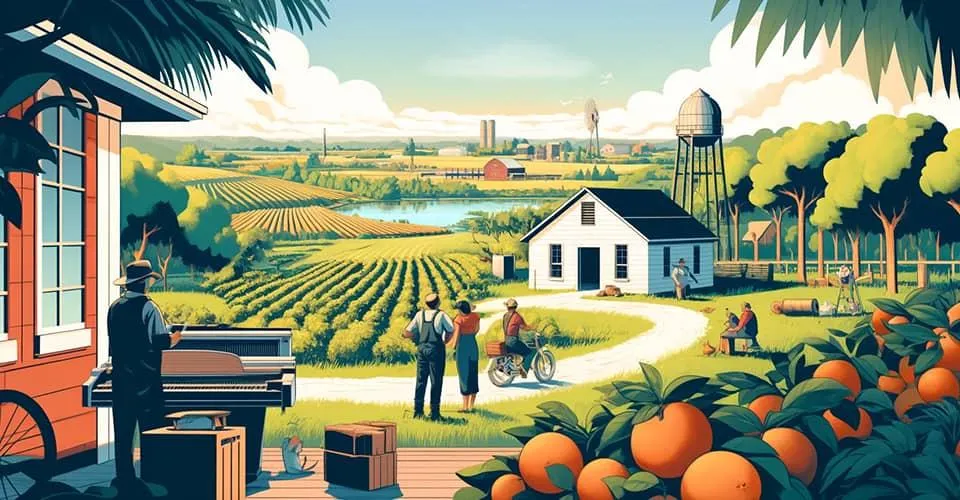USDA Home Loans in Florida
Get all the information you need to know about USDA
Loans in Florida. Read the article to view the guide on
eligibility, loan limits, and more.

The amount of equity you own in your home draws a direct correlation to the amount of money you put up as a down payment.
If you made a down payment of 10% on a property valued at $200,000, then the value of your equity is $20,000. As soon as you made the payment, you became the owner of $20,000 worth of the property.
Keeping up with your scheduled payments will see your level of equity increase over time in tandem with your accumulated payments. The property’s appreciation in value will give this a further boost.
Once it gets to a certain level, it will be possible to use this equity as an asset and you can borrow loans to repair, renovate, or expand your home. The funds might even be used as a down payment on a new property.
As you might expect, being able to make a substantial down payment will be an advantage on your path to building wealth using home equity.
Still, you might have to wait for longer to accumulate the money to make your first payment than someone who initially
puts less money down.
The USDA makes it possible for lenders to incorporate a lower proportion of your student loan debt balance in
their debt-to-income ratio calculations than other programs.
This allowance may make it easier for potential homeowners to purchase property, even while servicing their student loans.
Types of USDA Mortgage Loans
There are two categories of rural housing mortgage loans offered under the USDA umbrella:
Single-Family Housing Guaranteed Loan
Single-Family Housing Direct Loan
The USDA Single-Family Housing Direct Loan serves low and very-low-income applicants.
These borrowers are those whose median income falls between 50 to 80 percent of the area they reside in. Individuals can’t access USDA Direct Loans through private lenders, as the government issues them directly.
In this piece, our focus will be directed towards the Single-Family Housing Guaranteed Loan, which seeks to serve Low to Moderate-income borrowers.
These loans may be accessed through third-party private lenders, so you don’t have to make your applications directly to the government.
Fill out our form below to check your zero down USDA loan eligibility for free.
Requirements for USDA Loans
There are specific minimum requirements that need to be met for an applicant to qualify for a USDA loan.
These include being:
A permanent United States resident
A U.S. citizen
A foreign national
Ineligible for conventional mortgage services
Aside from these factors, there are various criteria that the USDA considers when making lending decisions, such as debt-to-income ratios, income levels, credit scores, and so on.
The USDA is unique in that it has two conditions that most other lenders do not, and these are:
Borrowers must be from qualifying locations.
Borrowers must meet the USDA income limits for loan qualification.
Qualifying Location
It's essential to keep in mind that the USDA's main objective is to develop the rural areas of this country, which is why it will only back loans in the regions that need increased homeownership rates.
The truth is, however, that you aren't strictly limited to making your property purchases in rural areas, as you can access these loans in rural and suburban areas as long as they meet certain qualifying characteristics:
Populations at or below 10,000 in rural areas or open country.
Populations at or below 20,000 outside an MSA (Metropolitan Statistical Area).
Severe lack of mortgage opportunities for low- to moderate-income applicants.
While it might seem that these requirements disqualify most borrowers hoping to purchase homes near
cities, the reality is that 97% of the entire USA landmass falls within the criteria for USDA loan approval. This area covers approximately 34% of the country's population.
The USDA has made it easy to determine whether a property is eligible for their program by providing an interactive eligibility map that only requires one to zoom in on the property or type in the relevant home address.
Rural Character According to the USDA
According to the USDA, a source of confusion for many potential borrowers is the phrase 'Rural in character' and what this means. They consider areas with a population density of or below 1,000 persons per square mile rural.
Even so, the USDA considers local circumstances when making their decisions, so you might still qualify even though Google tells you that your town falls outside the zone of eligibility.
These factors include local university student numbers and economic circumstances to determine the area's actual population density.
You will find the agency approving loans to borrowers in areas that are part of the MSA or have populations over 35,000 should the area residents with low to moderate incomes face difficulties accessing mortgage loans or if the city has a rural character.
Note: At the end of the day, it is always worth taking the time to find out whether the home you wish to purchase lies in a USDA-qualified area, as the criteria may not always lead to obvious conclusions
Income Limits
One of the overriding goals of the USDA is to provide borrowers with low to moderate incomes the opportunity to own their own homes.
As a result, the USDA functions differently from other loan programs in that there are income caps or limits that determine how much a borrower can earn while still being eligible for loans from them.
The methods lenders use while calculating the income of USDA loans are unique in the mortgage loan industry. Most lenders will look at the applicant's income for loan qualification.
Married borrowers will have both their incomes scrutinized, but should only one of them make the application, then only their information or credit score will be considered.
The USDA operates differently, as it considers the following three figures when determining eligibility according to income:
Qualifying income - Income that indicates the borrower's ability to repay the loan.
Eligibility Income - A household's total income that includes the income of any children who are earning an income although they are still dependents.
Adjusted Eligibility Income - This is a household's income after any deductions are made.
Qualifying Income
Just as it is for most mortgage types, this process involves the submission of an applicant's current income as evidence of their ability to pay back the money they wish to borrow.
Lenders will typically scrutinize the applicant's future home payments and current debt obligations against their current income.
Eligibility Income
The USDA considers the incomes of ALL individuals residing in a household, no matter how old they are. For a married couple with a working 20-year old child living with them, their eligibility will be determined after adding up their earnings.
This is because the USDA considers the median income of the households rather than the applicant's income.
Adjusted Eligibility Income
This is the final consideration made by potential lenders as they evaluate applications. The USDA gives lenders the authority to subtract certain expenses from borrowers' household incomes.
These include:
100 % of childcare costs.
$480 for each disabled adult or minor child that is a co-borrower, non-borrower, and is not the spouse of the borrower.
$400 for borrowers or co-borrowers over two years old, although this deduction may only be applied once per mortgage loan.
Medical expenditure that comes to over 3% of the total household income, expenses related to any household member's disability, or if the borrower is an elderly citizen.
Since income limits are determined by geographical location, you might find that your eligibility changes as you consider different areas for your property purchase.
If, for example, you wish to purchase a home near the City of Oklahoma utilizing a USDA Guaranteed Loan, you might face an income limitation of $91,000.
On the other hand, if you search for a house near Irvine, California, this might drastically change to $156,250 due to the higher housing costs.
To determine whether or not you qualify for USDA loans according to their household income requirements, you can check out their county-by-county list of income requirements.
To make things easier, click on your particular state on the map to jump to the relevant part of the list rather than scrolling through the entire list.
To figure out what deductions you qualify for, they also provide an income eligibility calculator.
Contact a USDA lender for more detailed information and advice on how you can attain eligibility status and earn
the maximum amount of deductions you deserve.
Final Thoughts
Do not give up hope if you find that your income levels disqualify you from receiving a USDA loan. First of all, try and see where you might qualify for additional deductions.
If this doesn't offer any solutions, check whether you are eligible for FHA or VA loans, which call for 3.5 % and 0 % down payments, respectively.
You might also look into conventional loans requiring 3% down payments. The advantage of these is that no income limit restrictions that apply to them. Good luck!
Find The Right Mortgage
For more than 20 years, Phil have been helping customers achieve
their home purchase and refinance goals by providing them with
invaluable resources and support.

Squeezed from Florida

Next Wave Mortgage, LLC | NMLS ID 2536820
Copyright © 2024 Make Florida Your Home. All Rights Reserved.
Quick Links
Next Wave Mortgage is not affiliated with any government agencies. These materials are not from VA, HUD or FHA, and were not approved by VA, HUD or FHA, or any other government agency.
Reverse mortgage borrowers are required to obtain an eligibility certificate by receiving counseling sessions with a HUD-approved agency. The youngest borrower must be at least 62 years old. Monthly reverse mortgage advances may affect eligibility for some other programs.
This is not an offer to enter into an agreement. Not all customers will qualify. Information, rates, and programs are subject to change without notice. All products are subject to credit and property approval. Other restrictions and limitations may apply.
Complaints may be directed to: [email protected]. For licensing information, please visit http://www.nmlsconsumeraccess.org


